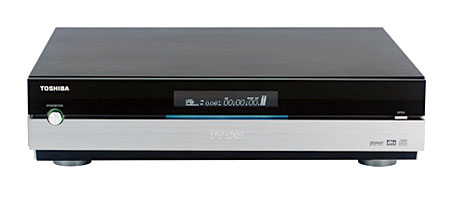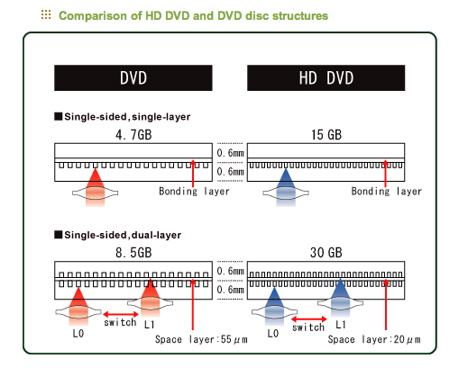HD DVD and Blu-ray Disc 2006: An In-Depth Report

Toshiba's HD-XA1 HD DVD Player
For the last several years anyone who's bought a TV that costs over $1000 has some form of HD compatibility. The vast majority of prime time television shows broadcast by the major networks are now available in HD in all the major markets, and so is an ever- growing percentage of sports programming. By 2009 analog broadcast in this country is mandated by Federal law to come to an end. HD movies On-Demand are available in many major markets from the cable companies, and HBO and Showtime, and several other cable and satellite movie channels are showing HD nearly 24/7. Watching movies on our silver discs is the only area in which the transition to HD has been slowed, but now the wait is over.
HD video on a 5"silver disc (don't call it DVD) is something that enthusiasts have been anticipating for a long time. The studios have been preparing their libraries in HD for years now-virtually every major release DVD we've all been watching for the better part of the last decade has been downconverted from HD transfers. While watching these HD presentations on satellite, cable, or even over-the-air is terrific, the enthusiast wants to rent or own these movies on a silver disc, taking complete control of the playback experience, which by the way has the potential to be even better in terms of both picture and sound than any HD we've yet experienced.
While the advent of HD on a silver disc is nothing short of momentous, it's being born in greater climate of uncertainty than I'd like. There are not one but two competing formats, and the first-generation players are lacking technologies we know we'll see in future player generations. Consumers are confused and perhaps even apathetic, and everywhere I turn people are being urged not to jump in and start experiencing HD on disc, but to wait out the format war and see what happens.
Whatever you decide, our job here is to do the best job we can in these confusing times to arm you with the information you'll need to make an informed decision. Rumors and speculation regarding the capabilities and standards of the formats, the players, and the ancillary standards (like HDMI, and the new codecs from Dolby and DTS), and the software have been all over the map. Even as these first generation players are arriving, it's difficult to tell if what we're seeing is the result of the formats' capabilities or the players' idiosyncrasies. But here's what we know now.
Physical Disc Structures
The HD DVD format was co-developed by Toshiba and NEC. Over a year ago, when HD DVD was poised for a large scale but ultimately aborted 2005 holiday season launch, representatives from major disc replicators claimed to be able to switch over their facilities to mass production of HD DVDs in about half an hour. Cheaper tooling and disc replication costs were also claimed. These advantages were major selling points in convincing content providers to support the format.

By using smaller "pits"in the disc structure and a shorter wavelength laser, HD DVD increases the storage capacity over the current DVD by three-fold in both single and dual-layer configurations. Where a single layer DVD is capable of 4.7GB of storage, a single-layer HD DVD disc holds approximately 15GB. Dual-layer HD DVD discs up that to nearly 30GB, which is half the capacity of the hard drive in the laptop I'm using as I type this article!
The Sony/Matsushita/Philips backed Blu-ray Disc (BD) format goes even farther in its storage capacity. Single-layer discs are 25GB, dual-layer discs are 50GB, and it's reputed that multi-layered discs with even higher capacities to have been experimented with, and are only a generation or two down the road. But the BD format is an entirely different physical disc structure than the current DVD format. Tooling for mass production will require entirely new components, and in addition to being more expensive to replicate BD titles, it might take longer to reach full mass production potential. For BD to succeed, reaching mass production in a hurry could be essential. Sony's SACD format suffered from a lack of mass replication support for its hybrid discs, which played a part in that format's commercial failure in spite of its unquestionably superior sound quality.
Both formats claim the ability to manufacture hybrid discs that contain standard definition layers compatible with current DVD players and HD layers that will be read by the next-generation players. This would be advantageous for obvious reasons. Consumers might be inclined to hedge their next-gen format bets by spending an extra couple of bucks to buy a disc they can play in their current machines, and also play in a next-gen player down the road. Just how likely consumers might be to buy these hybrids is hard to say without knowing what the exact premium in cost will be, or how well educated the consumer will be when buying these discs.
The Blu-ray hybrid discs were developed by JVC, and have been demonstrated at trade shows. These hybrids contain a dual-layer 9GB DVD-ROM and a single-layer (25GB) BD-ROM on the same disc. The BD layer is simply invisible to the red lasers used in current DVD players.
HD DVD's hybrid discs are also reported to allow for a dual-layer standard DVD layer, but only a single 15GB HD DVD layer, which may put such discs at a disadvantage in picture and sound quality due to the limited "bit budget."There has also been talk of a "combination"disc that would have a dual-layer DVD on one side of the disc and a dual-layer HD DVD disc on the other side. We'll have to wait and see what actually shows up at retail to know for sure.
Note too that both formats' players are currently specified to playback current standard DVD discs. At press time, while we know for certain that the first Toshiba HD DVD players also playback redbook CD, we've confirmed that the first generation players from at least Pioneer and Sony will not. Shocking, but apparently true.
Storage capacities are critical when regarding the next topic of conversation, which are the video codecs used in authoring these discs. Indeed, the perceived quality of both formats may depend mightily on this issue of disc real estate.
What We'll See
The HD we're going to experience on both HD DVD and Blu-ray isn't going to simply be the HD we're currently seeing on cable and satellite ported over to a disc. It has the potential to be far superior and involving, with 1080p video and sound quality that simply hasn't been available on any consumer format.
In terms of the video compression codecs available for authoring the video on these next-gen discs, Blu-ray and HD DVD have more in common than not. Both formats support Advanced Video Coding (AVC H.264, also known as MPEG-4,) our old friend MPEG-2, and the Evil Empire's (Microsoft) Video Codec 1 (VC-1), also referred to as Windows Media Video 9 (and, at one time, called VC-9). According to both camps, all three compression codecs are available to studios for authoring in the sense that first generation players from both formats will support all three codecs.
























































